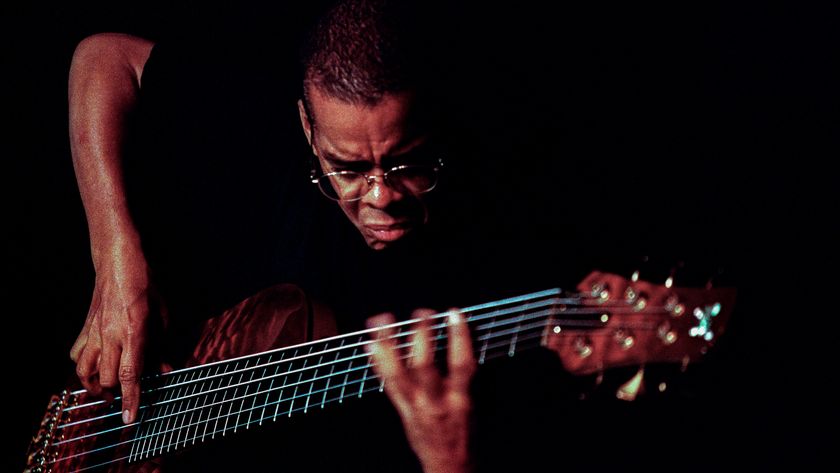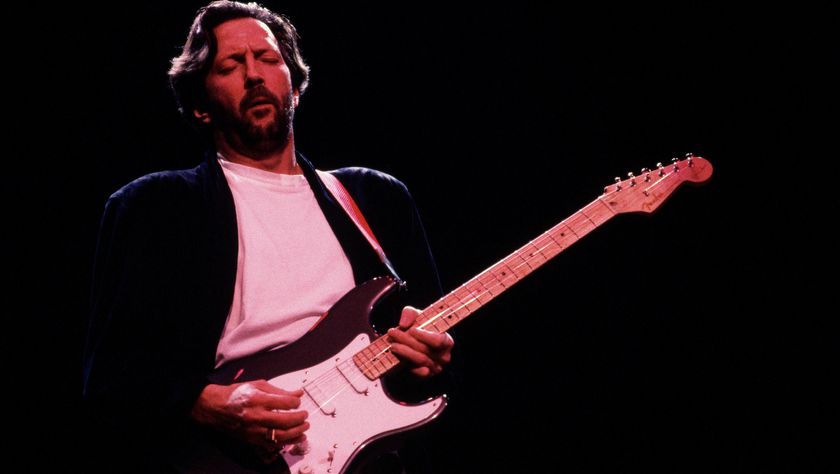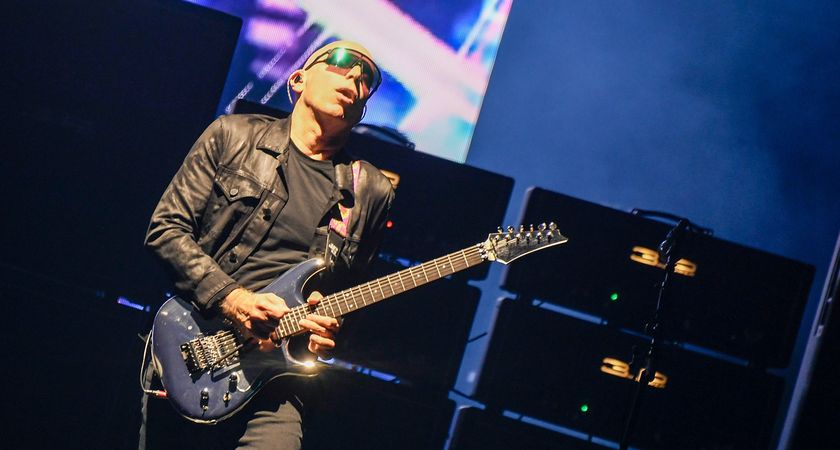Albert Lee Talks Gear, B-Benders, "Cocaine," "Country Boy" and Clapton

He’s a veteran breakneck picker and fingerstylist who has performed with Eric Clapton among many others. But what Guitar World readers really want to know is…
My all-time favorite Albert Lee solo is on Eric Clapton’s live Just One Night version of “Cocaine” [recorded December 1979]. What can you tell me about it? What gear were you using? —Jim Mikmaq
I have a fairly fluid technique, and sometimes it runs away with me when I play too many notes. [laughs] I can’t remember exactly what I played, but I’d hazard to guess I played four times as many notes as Eric did on his solo, for good or bad. More than a few people thought it was Eric at the time, but the more you listen to it, the more you hear how different the two solos are.
I was using the Gibson Les Paul Custom Eric gave me. That’s the one he used with Delaney & Bonnie and Cream. He gave me that guitar when we started playing together in ’79. It’s one of my treasures. We were both using Music Man amps, 130-watt heads with large, open-back cabinets with two 12s.
What was it like being onstage at the Concert for George, the 2002 George Harrison tribute show at the Albert Hall? How well did you know him? —Lena Sciancalepore
It was quite an event and such a large band. There were six guitar players and three keyboard players. At one point, there were three or four drummers, and there was a small string section behind us. It was amazing, not only because it was for George but also just to be in the middle of all that.
George and I didn’t hang out a lot, but I’d met him a number of times and he was always very friendly. The first time I met him was at an Eric Clapton gig. At the ends of his tours, Clapton would do a local gig at a church hall just for the fun of it. George came to one of those. We went back to his house and had a jam. Then I ran into him at the first Australian Grand Prix in ’85. He showed me around the pits and introduced me to the drivers, because he was into Formula One.
Get The Pick Newsletter
All the latest guitar news, interviews, lessons, reviews, deals and more, direct to your inbox!
When performing, do you make up your “Country Boy” solos on the spot? [The song was a 1971 hit for his band, Heads Hands & Feet, and was later covered by Ricky Skaggs.] —John Thomas
In all the breaks in “Country Boy,” there are certain things I will go to. But even though I start out playing something I’ve played before, it always ends up being different. It’s the nature of my playing. I’m lucky enough to be able to think on my feet and let things take their own course. If I make a mistake, I’ll turn it into something else. None of my solos are planned, but you’ll notice a certain familiarity if you’ve heard me play a number of times.
How often do you practice, and do you follow a regimen? —Earl Pobjoy
[laughs] Not at all. I’m fortunate enough to have a technique that comes together pretty quickly. I pick up a guitar and everything falls into place, more or less. If I’m not working for two or three weeks, I generally won’t pick up a guitar. I might pick up an acoustic and strum a bit, but that’ll be it. And I generally don’t warm up for gigs. I should, really. I guess soundcheck is good enough. I’m sure that if I were to spend time practicing, I’d come up with some new things.
What string gauge do you use? —Mike Caro
I’m using .010 to .046, an Ernie Ball Regular Slinky set, except I’m using a .015 instead of a .017. I like to be able to bend that third string. When I started using pre-gauged sets, I used Fender Rock N’ Roll strings, which were .010, .013, .015, et cetera. That’s what I’m using now, but with Ernie Ball.
Were you involved with the unusual shape of your Music Man Albert Lee model guitar? —Pete Canard
I didn’t design it. It’s different, but I don’t think it’s weird looking. I see a lot of guitars people play now, and I think, Boy, that thing is ugly. They’ve got ugly horns on them and they look like a battle ax from the Middle Ages or something. I think this one is very cool, because it’s understated but doesn’t have the curves of a Strat-type guitar.
How did the Albert Lee/Music Man association come to be? —Gifford Pinchot
When I first came to the States with Head Hands & Feet, we were playing in Los Angeles, and our record [“Country Boy”] had been on the radio. Ernie Ball and his son Sterling heard it, liked it and were surprised to find out we were English. They came to gigs, we became friends, and I started using Ernie Ball strings. Sterling’s godfather was Tom Walker, who started Music Man with Leo Fender, so I was showered with Music Man amps in the early Seventies.
Leo left Music Man to start G&L, and Ernie ended up buying the Music Man name. They decided they wanted to build a new electric guitar. A number of us pitched in our ideas. Even Steve Morse was involved. The first guitar they came out with was the Silhouette, which I loved. But they also made a prototype, which they tried at the NAMM Show, but there wasn’t much interest. They kind of shelved the idea for a while, but Sterling had a nice prototype made up for himself, which was all maple. He told me about it: “You’ll love this guitar when you see it.” I fell in love with it, and he gave it to me. That became my main guitar.
At that time, it was called the Axis. I played it for a number of years. They weren’t able to do much with it at that time, because they had limited production and they were starting to make guitars for Eddie Van Halen. So I had to wait until they built a new factory. That’s when they brought out my guitar. They’ve been quite popular. I’m fortunate to have a first-class guitar with my name on it.
What amps are you using these days? —Zooey F.
I use Fender Tone Masters. In the late Seventies when I joined Clapton’s band, he was using Music Man amps, and he had vents cut in the back of his big cabinets. I thought that was a great idea. I never really liked the idea of a big 4x12 closed-back cabinet. I know it’s supposed to be more efficient, but I just like the overall surround-sound of an open-back cabinet, like you’d get from a Twin. So I had the idea of having cabinets built like Eric’s. The first thing I did when I got my Fender Tone Master was cut ports in the back of them. They work really well. I love the sound of them.
Why and when did you start using B-benders? —Lucy Lepore
I was mesmerized in the late Sixties listening to Clarence White bend strings, thinking, How did he do that? It’s too perfect to be a regular string bend! Then I read about the StringBender [the mechanical device invented by White and Gene Parsons that's now known as the B-bender], but I still couldn’t picture it. On my first trip to the States, we went to see [bluegrass band] the Dillards. I went backstage and met their guitarist, Billy Ray Latham, and he had this Tele with a B-bender in it. I think his was made by Gene Parsons—one of the originals.
I said, “Where can I get one?” He said, “There’s a guy in L.A. making them named Dave Evans.” He was making Tele bodies out of exotic woods. I bought one of the bodies, and he put a humbucker in it. This would’ve been around ’71 when I started playing my B-bender. Not long after that, Evans kind of disappeared, but I’m glad to say I’m back in touch with him.
I loved Gene Parsons’ units, because they were the first. Actually, I have to qualify that, because I saw Carl Perkins play a Gibson Switchmaster in the U.K. He had this little bit of metal he’d attached to the headstock. When he was playing in the first position, he could press this little lever with his thumb and it would raise the second string a whole tone. He could get these banjo bends with his thumb.
I have two or three Teles with B-benders and three of my signature Music Man guitars with B-benders. You can’t buy them; I had them modified by the factory. Sterling called me recently and said, “Joe Bonamassa wants one of your guitars with a B-bender in it. Are you okay with that?” I said, “Of course I am!”
I know you’ve done clinics for Ernie Ball, but do you offer private or online lessons? —Clarence LeBlanc
I’ve had people over to the house once or twice, but I’m not a good teacher. I’m self-taught. I had piano lessons for a couple of years, but there was no one to learn from in 1957. It was just from listening to records. You start out with Buddy Holly solos and go from there. When I do clinics, I show people how I came across things, and I tell them, “This may or may not work for you.”

Damian is Editor-in-Chief of Guitar World magazine. In past lives, he was GW’s managing editor and online managing editor. He's written liner notes for major-label releases, including Stevie Ray Vaughan's 'The Complete Epic Recordings Collection' (Sony Legacy) and has interviewed everyone from Yngwie Malmsteen to Kevin Bacon (with a few memorable Eric Clapton chats thrown into the mix). Damian, a former member of Brooklyn's The Gas House Gorillas, was the sole guitarist in Mister Neutron, a trio that toured the U.S. and released three albums. He now plays in two NYC-area bands.

“Jeff was playing through his dodgy Marshall and didn’t like the sound. He said, ‘We’ll do it again, later on…’” Mick Rogers may be in possession of Jeff Beck’s last-ever studio recording

“I could try and recreate his vibrato for the rest of my life. It’s never going to happen. If I got to play his guitar through his rig, it’s not gonna sound like him”: Tony Iommi changed his life – now Scott Ian is playing Sabbath’s last stand









